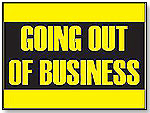|
|
Predictions for ’09: The Big Get Bigger and the Small Go Away Annual Forecast Shows Grim Outlook for the Little Guys
 Tuesday, January 27, 2009 – Right now, we are looking back on the worst fourth quarter in toy history and are looking forward to an even worse first quarter. The first 90 days of the year are historically slim pickings at the best of times, and these are not the best of times; the ongoing frantic efforts from big retailers to slash inventory will make sure of this. Wal-Mart, Target and Toys “R” Us are devoting unprecedented space to toy clearance sales, which means continued heavy discounting and no new purchase orders for the manufacturers. Tuesday, January 27, 2009 – Right now, we are looking back on the worst fourth quarter in toy history and are looking forward to an even worse first quarter. The first 90 days of the year are historically slim pickings at the best of times, and these are not the best of times; the ongoing frantic efforts from big retailers to slash inventory will make sure of this. Wal-Mart, Target and Toys “R” Us are devoting unprecedented space to toy clearance sales, which means continued heavy discounting and no new purchase orders for the manufacturers. NO CONSOLATION FOR CONSOLIDATION Bad as this is, I hope it is only a passing phase. However, what I see emerging is a significant acceleration in the trend toward consolidation in the U.S. toy market, which is most certainly going to affect both retailers and manufacturers to a very painful degree. Consolidation at the retailer level has been ongoing for years. Most affected were the small mom-and-pop retailers that are probably half in number today compared to a decade ago. Estimates are that the current number will drop by a breathtaking one-third by end of this year. Declining store traffic, drying-up of credit lines and dwindling vendor numbers point to a major shake-out in the next few months.  This trend is unlikely to stop at the small guys, as KB Toys has demonstrated. There are signs that even the largest retailers are not immune. Vendors tell me there are issues with Sears, Kmart and Toys “R” Us. The same vendors have learned the hard way that the first sign a retailer is in trouble is when they change payment practices or try to switch from Letters of Credit to open account. This trend is unlikely to stop at the small guys, as KB Toys has demonstrated. There are signs that even the largest retailers are not immune. Vendors tell me there are issues with Sears, Kmart and Toys “R” Us. The same vendors have learned the hard way that the first sign a retailer is in trouble is when they change payment practices or try to switch from Letters of Credit to open account. However, the consolidation trend is likely to go further to encompass small- to medium-sized toy manufacturers as well. Apart from the fact that they are facing a declining retailer universe, a continuous drop in consumer demand and a constriction of credit availability (which for an industry with the seasonality profile of Mount Everest is a major issue), they are now challenged by a very significant new factor — safety testing. TESTING TRIMS DEVELOPMENT This is really a big deal. All toy manufacturers and importers will need to be able to demonstrate, on the basis of arms-length testing results, that their toys meet the CPSC-imposed safety criteria. Specifically, they have to be able to produce test results proving that their products do not exceed 600 parts per million of lead by Feb. 11, a level that will be further reduced to 300 ppm, effective Aug. 14, and cut to 100 ppm (if deemed feasible by the CPSC) in 2011. In addition, they have to be able to produce test results showing that they meet all other safety criteria (phthalates, cadmium, etc.) by June 1. Given that the average cost of such testing is somewhere between $1,000 and $5,000 per toy, this will effectively kill a high percentage of products put out by small- and medium-sized toy manufacturers. It will also, to a major degree, throttle new product development by the same manufacturers.  Due to the four factors — declining consumer demand, a dwindling retailer universe, constricted credit availability and the cost of safety testing — I would not be surprised if the number of importers and manufacturers in the United States is halved by year-end. The outgoing businesses will have a lot of company, given that 200,000 businesses and between 2,000 and 3,000 malls are projected to go to the wall nationwide between now and the end of 2009. Due to the four factors — declining consumer demand, a dwindling retailer universe, constricted credit availability and the cost of safety testing — I would not be surprised if the number of importers and manufacturers in the United States is halved by year-end. The outgoing businesses will have a lot of company, given that 200,000 businesses and between 2,000 and 3,000 malls are projected to go to the wall nationwide between now and the end of 2009.BIG = PROFIT We know who is going to suffer, but who is going to profit from all this? Firstly, the big retailers will definitely benefit from a contraction in the retail base because this reduces their competition. They will not be concerned about the shrinkage in the mall universe, as they do not typically operate in malls. Secondly, the big manufacturers will profit. They are at home with the big retailers and will benefit from any increase in their store traffic. They are not concerned about testing costs because these have been part of their expenses for years, at least to some degree. They can handle the credit issues because they have deep pockets and good credit lines. And finally, they are less affected by the decline in consumer demand for toys because they have strong and heavily promoted brands that are holding up fairly well during bad times. In the long term, the consumer will lose out. Fewer small manufacturers means less innovation, and fewer small retailers means less readiness to give a new and untested toy a try.  Writer's Bio: Lutz Muller is a Swiss who has lived on five continents. In the United States, he was the CEO for four manufacturing companies, including two in the toy industry. Since 2002, he has provided competitive intelligence on the toy and video game market to manufacturers and financial institutions coast-to-coast. He gets his information from his retailer panel, from big-box buyers and his many friends in the industry. If anything happens, he is usually the first to know. Read more on his website at www.klosterstrading.com. Read more articles by this author Writer's Bio: Lutz Muller is a Swiss who has lived on five continents. In the United States, he was the CEO for four manufacturing companies, including two in the toy industry. Since 2002, he has provided competitive intelligence on the toy and video game market to manufacturers and financial institutions coast-to-coast. He gets his information from his retailer panel, from big-box buyers and his many friends in the industry. If anything happens, he is usually the first to know. Read more on his website at www.klosterstrading.com. Read more articles by this author |
| |||||||||||||||||||||||||||||||||
Disclaimer Privacy Policy Career Opportunities
Use of this site constitutes acceptance of our Terms of Use.
© Copyright 2025 PlayZak®, a division of ToyDirectory.com®, Inc.



